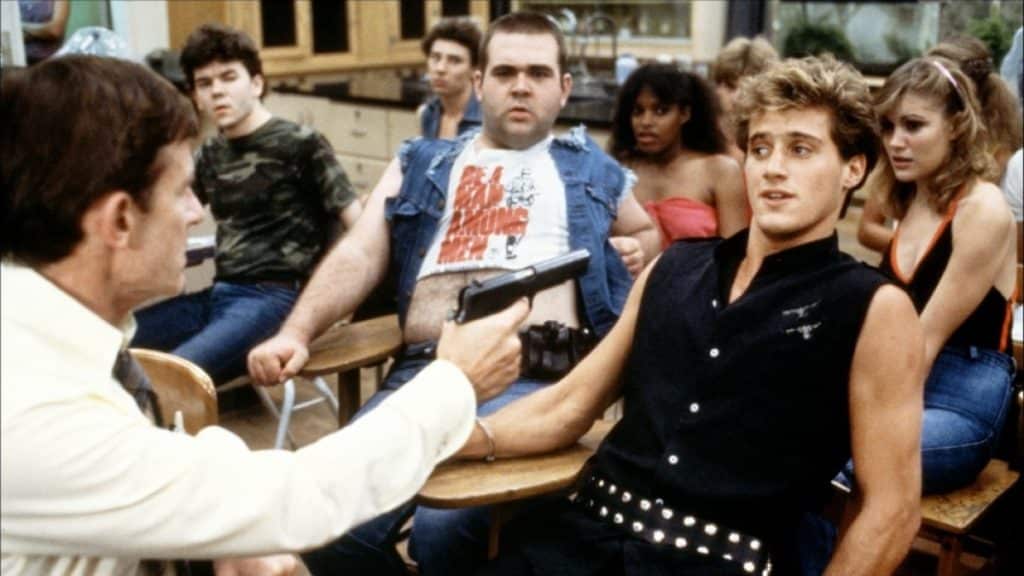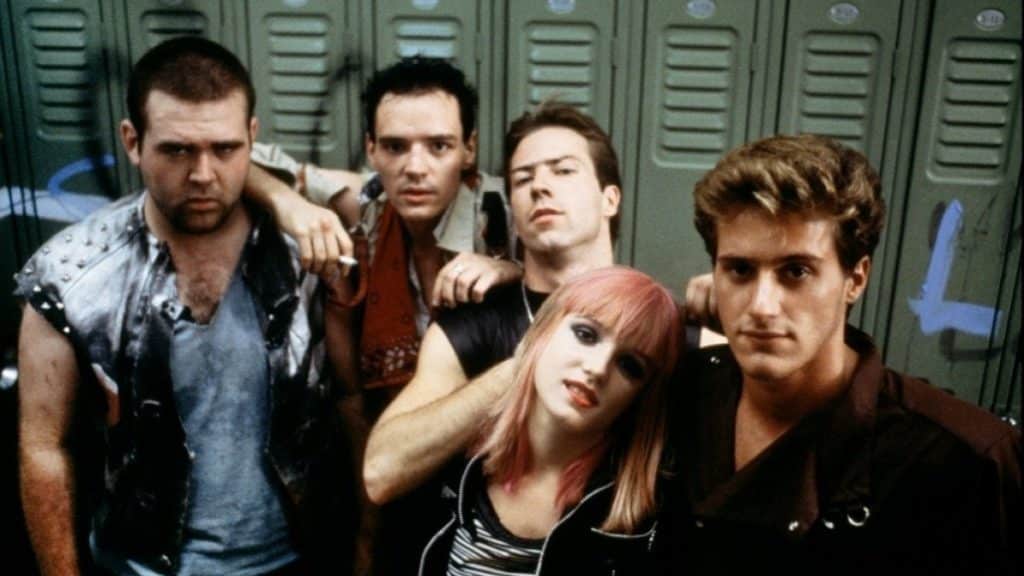The sleazy exploitation film offers surprisingly more in terms of style and substance than a viewer might expect.
When people first came upon Class of 1984 in theatres at the tail end of the summer of 1982, they likely had expectations about what they would see. Those not instantly put off by its sleazo ad campaign likely assumed they would be encountering a trashy update of The Blackboard Jungle. Perhaps one with far more blood, guts, and nudity than would have been permissible back in those comparatively innocent days of 1955. In many ways, that is essentially what it was, and that is how many people at the time chose to dismiss it. However, true fans of exploitation cinema came out of it with a genuine sense of surprise over what they had just seen. Here was a film that looked and sounded like the usual garbage but had far more wit, style, and intelligence than anyone expected. Those qualities continue to impress even today.
The film stars Perry King as Andrew Norris, the new music teacher at the run-down inner-city Lincoln High. Upon arrival, he encounters fellow teacher Terry Corrigan (Roddy McDowall), who shocks the new educator by revealing he carries a firearm. The shock continues when Norris finds everyone must go through metal detectors. Things are so overwhelmed that when a kid slips through with a razor, the swamped guards simply let him go. When he gets to his first class, he has his initial encounter with Peter Stegman (Timothy Van Patten), the leader of the gang responsible for most of the mayhem. After some harassment, Stegman and his four flunkies walk out of the class, leaving Andrew to deal with the rest (including one played by an impossibly young-looking Michael J. Fox).

What complicates things for Andrew is that while Stegman may be a violent, drug-dealing thug, he is uncommonly intelligent and a budding musical prodigy. In the tradition of countless inspirational movies involving caring teachers and troubled teens, Andrew tries to reach out to him but, suffice it to say, it doesn’t work. At one point, Stegman even goes so far as to pull a Scorpio by deliberately injuring himself and then accusing Andrew of having done it. Andrew even tries to talk to Stegman’s mother, but she won’t hear anything about her son’s actions.
The violence continues to escalate—Terry finally snaps and comes to a bad end while Fox’s student gets shanked in the cafeteria—and everything culminates on the evening of Andrew conducting the school orchestra in their first show. While preparing for school, Stegman and the rest of the gang break into his house and gang-rape his wife (Merrie Lynn Ross), taking Polaroids that they slip onto his podium just before the start of the show. Fully enraged, Andrew bolts from the stage and begins hunting them throughout the school, killing them off one by one before his final confrontation with Stegman high above the unsuspecting crowd of music lovers.
Needless to say, Class of 1984 has aged in strange ways in the forty years since it first arrived in theaters. Contemporary viewers won’t blink an eye at the sight of metal detectors in a high school but may raise an eyebrow at the notion of an institution like Lincoln High still hiring a music teacher.
The Grand Guignol-style climax with Andrew and Stegman battling it out…is all the more impressive when you consider that it was all done on a presumably small budget.
However, while movies involving violence within the theoretically safe hallways of a high school were not entirely unheard of back then (the idea cropped up in such low-budget gems as Rene Daalder’s fascinating political allegory Massacre at Central High and Jack Hill’s cheerfully trashy Switchblade Sisters), this film pushed this idea to such a degree that it caused many viewers to react with a combination of condescension and revulsion. The review in Newsweek infamously dubbed it “The Class of 1982 with Herpes.” It wound up being censored or banned in numerous countries because of the brutality on display.
Yes, it is pretty brutal. Still, what its critics refused to acknowledge and its supporters (led by Roger Ebert) were quick to point out was that while it was designed and sold as sleazy, exploitative junk, it was several steps above its grindhouse brethren. One problem with revenge fantasies like this is that they often try so hard to whip audiences into a bloodthirsty frenzy that they become nothing more than gory and garish cartoons. Here, the film always manages to keep from flying completely off the rails. Even though it wants you to cheer as Andrew knocks off Stegman’s gang in increasingly grisly fashion, it doesn’t let you forget that he is still killing high school kids, lending an intriguingly queasy undertone to the mayhem.
Mark L. Lester, whose previous credits included such items as the drive-in favorite Bobbie Jo and the Outlaw and the immortal Roller Boogie, directed and wrote the feature. He demonstrated a certain flair behind the camera that set him apart from his fellow schlock directors. Here, he hits upon all the typical revenge movie beats but tackles them with more style than typically found in such films. As a result, it feels like a real movie instead of an assemblage of scenes featuring whatever actors managed to make it to the set each day. It even contains several genuinely amusing moments of dark comedy to boot. The Grand Guignol-style climax with Andrew and Stegman battling it out is a strong action sequence that is all the more impressive when you consider that it was all done on a presumably small budget.

The performances are also considerably better than one might expect from such a film. King, one of those actors who did some interesting films in the Seventies (including The Lords of Flatbush, Mandingo, and Andy Warhol’s Bad) without ever quite breaking through to full stardom, is very good in the potentially thankless role of Andrew. He’s believable both as an idealistic educator and a guy pushed too far and out for blood.
Years before he would become one of the most reliable directors in the HBO stable, Van Patten is fearsomely convincing as Stegman. The actor captures both the character’s psychosis and intelligence in intriguing ways. As for McDowall, he doesn’t do too much, but he does get to take center stage for the film’s single best scene, in which he finally loses it and pulls his gun on the troublemakers in class, demanding that they learn right then and there or else.
What its critics refused to acknowledge and its supporters were quick to point out was that while it was designed and sold as sleazy, exploitative junk, it was several steps above its grindhouse brethren.
When Class of 1984 finally came out, it inspired no small amount of controversy but did not quite break through to become a big hit. Instead, it quickly became a cult favorite as people discovered it via videocassette and cable. It eventually inspired a pair of tenuously connected sci-fi-themed sequels, Class of 1999 and Class of 1999 II: The Substitute, both easily ignored. Lester, on the other hand, did get enough notice from his work to get him the prime gig of replacing John Carpenter as the director of Firestarter. From there, he went on to such projects as Commando, Armed and Dangerous, Showdown in Little Tokyo, and the aforementioned Class of 1999.
Science-fiction author Theodore Sturgeon famously noted, “ninety percent of everything is crud.” When it comes to exploitation films, an artistic medium where the primary motivation almost always leans towards making a quick buck as opposed to actual artistic exploration, that percentage trends higher. And yet, fans of such films are still willing to sit through tons of uninspired and tacky junk in the hope that they will come across that rare film that stands out like a red rose in the middle of a sewer. Class of 1984 was just such a rarity. The combination of undeniably trashy elements and the surprising amount of intelligence makes for a potent combination that, once seen, is not easily forgotten.